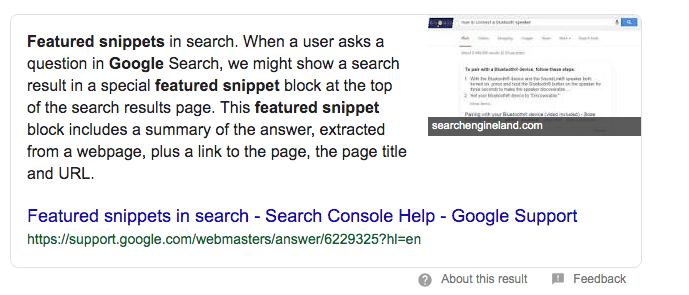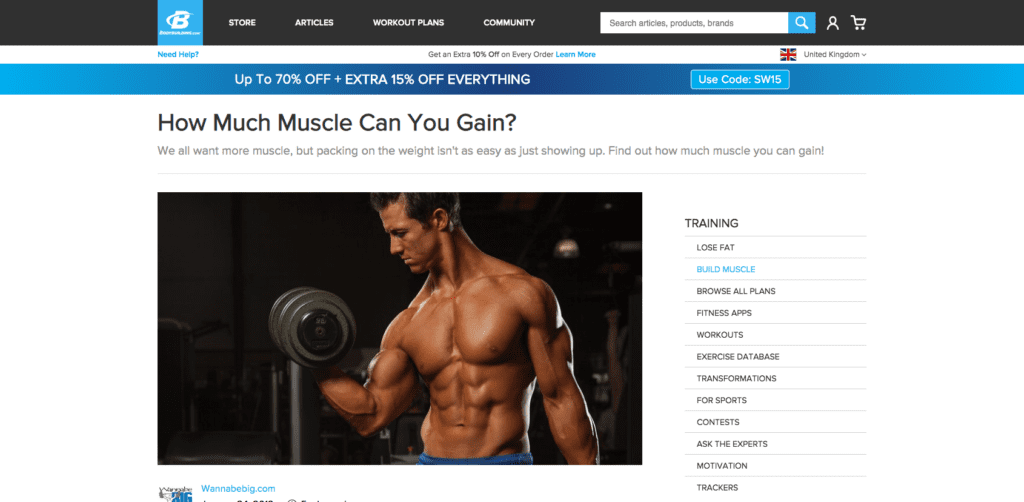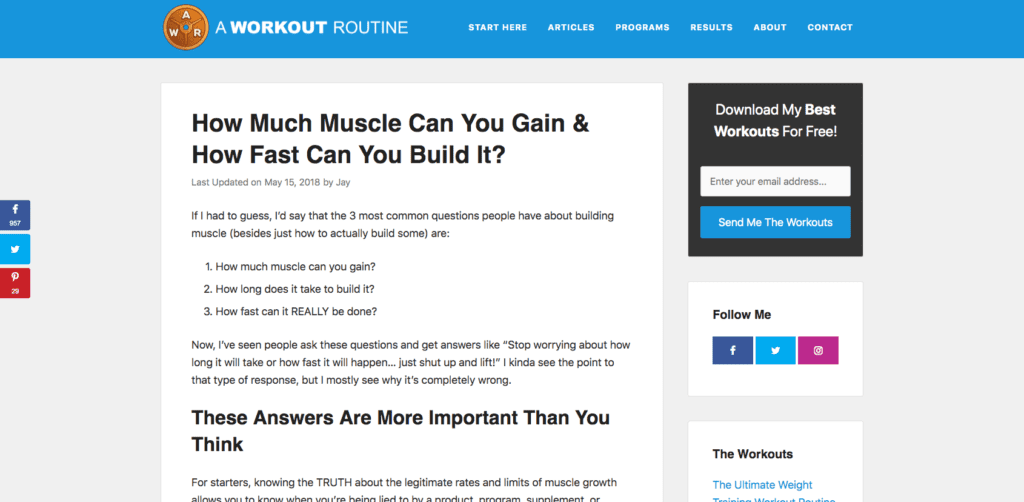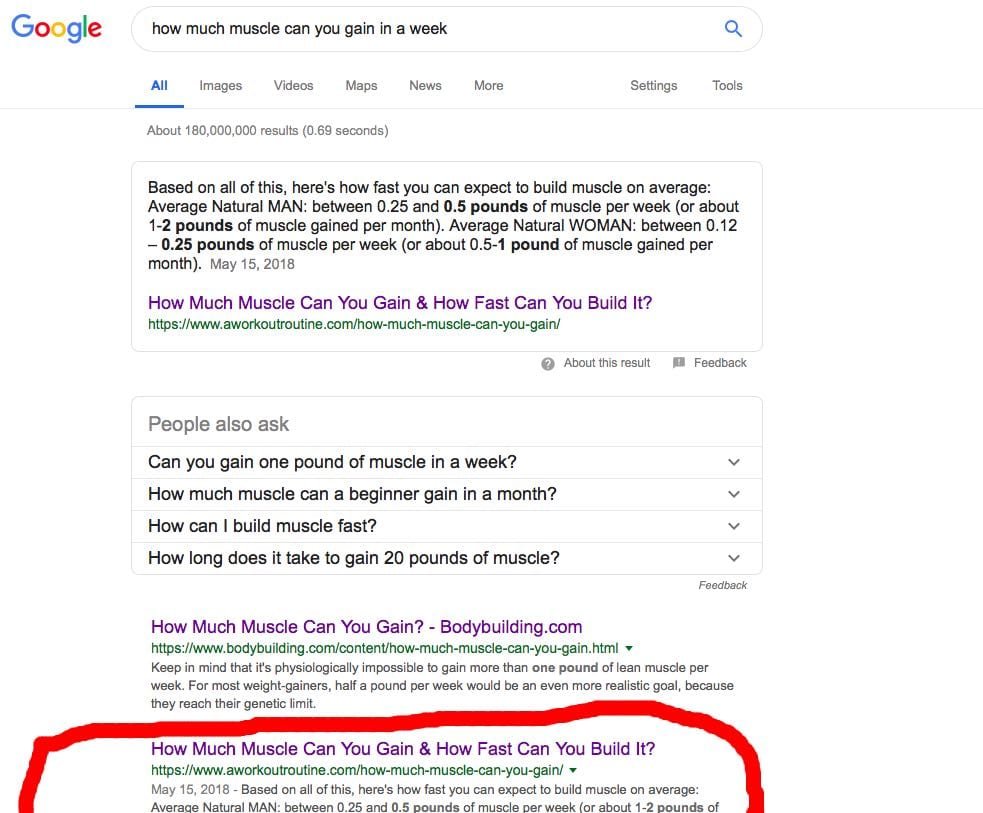Google Featured Snippets. They are a popular spot to try to get your content featured in in terms of the SERPs right now. And for good reason. Within a SERP result they are very visible and on many pages appear ahead of the actual ‘ordered’ SERPS results themselves.
What Are Google Featured Snippets?
In 2019, when you ask any question in Google or search with any keyword, a special block of information will often appear, a block that is known as a Featured Snippet.

This block will contain an extracted summary of the answer from a webpage, a link to that page, and most of the time, a related image (note, that image is not always from the same site, as is the case above.) Google extracts the summary programmatically. If you can place your site into the Featured Snippet in any way, your content will get extra attention from the person searching about that topic. The result? More clicks, more traffic. Good stuff. So a Featured Snippet is a place you want your content to be.
You can opt out from featured snippets (using <meta name=”googlebot” content=”nosnippet”> tag on your page). But according to Google, there is no way to mark your page with a featured snippet. It is a fully programmatic process. No humans involved at all.
How Do You Get Your Content Into Featured Snippets?
The common wisdom among those who have not taken too much time to delve into the world of Google Snippets is that this prime ‘search real estate’ would be given over to the website that ranks highest for the keyphrase searched or that has the most back links and such.
However, as I am about to show you, that is not the case, and if you want to get content from your site featured in these spots, then your SEO thinking may have to change a little (or a lot)
A Case Study of Featured Snippets: The Big Guy Does Not Always Win
As I like to think of myself as a fitness freak, let’s start this research with a phrase that I think I know what kind of sites will rank highest; “how much muscle can you gain in a week?”. I’m expecting to see one of the big fitness magazines here, because that would make sense, right? Except that’s not what you get. The Featured Snippet for this query belongs to aworkoutroutine.com.
Who? Look a little further down, to the SERPs results themselves and you see what I had expected to come up first. Bodybuilding.com. A big site many people have heard of. But the average searcher may not get that far because they have already seen that Snippet.
If you click on the site results for both articles, you’ll see that Bodybuilding.com’s is as you might expect. Glossy, big shiny stock image, and it’s a well-written post that makes use of the keyword well.

The Workout Routine page looks dull in comparison. No big picture, no fancy website. It’s a well-written piece though, full of great facts.

So how did this end up in the Featured Snippet? Because it makes use of bullet points and lists. It’s easy to read, and it features the exact answer to the question, directly. That’s what the Google Bots picked up, so that is what ended up featured.
David wins over Goliath. Score one for the little guy. This is actually repeated throughout all kinds of search results. So, if it’s not about overall rankings and Domain Rank etc what should you be aiming for if you want your content featured? Here are some pointers:
-
- Structure your post better than your competitors for that keyword or keyphrase. Snippet bait helps here. Snippet bait is a 40 to 60 words block of information designed to be featured on FS. This short block of information should clearly answer the question you are targeting. Like the one used by A Workout Online.
- Optimize your content for mobile search. If your content is not mobile friendly, it will be exceptionally hard for you to get a place in the featured snippet.
- Use H2 and H3 tags. These will help Google bots to identify your information fast.
- If you use an image, make sure it is alt-tagged with the keyword. Even if only your image shows up a snippet, it’s still great visibility for your piece.
- Use a table of facts for quick summarization. Summary and tables of facts are also useful in helping readers to get a quick summary of the content.
- Look for competitors’ featured snippets using SEO tools like SEMrush. And then in your content, write a better one.
- Of all the snippet types (paragraph, table, and list), a paragraph snippet performs better. So, spend more time optimizing your content for those
- To rank for a list snippet, a step-by-step guide content is most often chosen for an FS. Use H2/H3 subheading tags for every step name.
- If you want to rank for table snippet, use tables in your content with quick facts. Table structure should be simple but well formatted so that the Google bot can easily pull data from it.
These are only a few things you need to take into consideration, the other SERP ranking factors still matter. Not every query displays a Featured Snippet (yet anyway) and so making it to the top of the SERPs query in the traditional manner still matters.
As you can see from my case study the two articles are the #1 and #2 results, so they still do that right too, but the fact that there Body Building edges out A Workout Online shows that the standard factors of DA, backlinks etc. are coming into play, as Body Building is the clear winner there:


Am I saying you should create content just with the goal of making it into Featured Snippets in mind? No. Am I saying that well-structures, easy to read informative copy has a much better chance of making it there? Yes. So if all you focus on right now is slotting keywords into your copy and give little thought to the way it is structured that needs to change, not just to improve your chances of making it into the hallowed ground of the Featured Snippet but also to make it far more useful to your readers as well.





